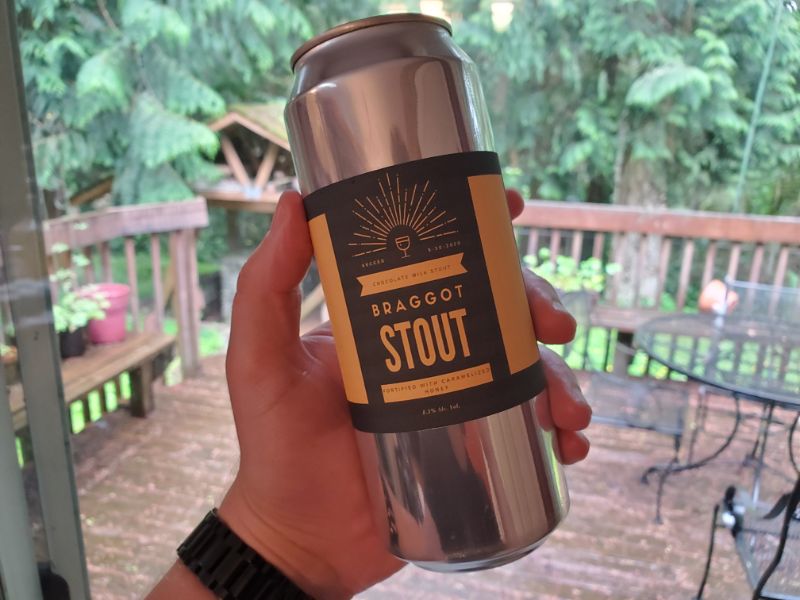A bochet-style braggot stout (with a chocolate milk stout as a base)
Originally Posted: Aug. 6, 2020

Table of Contents
Quick Specs
- Est. OG = 1.095 (1.060 without honey)
- OG = 1.080 actual
- Est. FG = 1.022
- FG = 1.017
- ABV: 8.3%
- Taste Profile: Chocolate flavor and lactose creaminess dominate, caramelized honey mostly in the background
- Time: About a month between brewing and kegging. The remainder of my supply is still cellaring.
- Yield: 5.5 gallons
Intro
I had decided to do a variation on my Basic Apple Cyser mead with caramelized honey at one point, and I noticed that the resulting Bochet Cyser was super dark. Dark like a stout. And thus I was inspired.
I had been interested in brewing a Braggot ever since I’d heard of them. A braggot is a mead-beer or a beer-mead, depending on how you look at it; it’s a beverage that has both malt and honey making up the majority of its fermentables. However, this was the first time I had a specific recipe idea in mind, and a stout version at that.
I searched online for a suitable stout recipe to base this on, and stumbled on one by E. C. Kraus. I think it was the image of a glass of stout being held up in front of a campfire that inspired me; caramelized honey can lend a toasted-marshmallow flavor to meads, and the campfire reminded me of s’mores. I had my base beer recipe.
Brief History
The word braggot (alternatively spelled “bragot”, “bracket”) is of Welsh origin. It could refer variously to mead brewed with hops to mead brewed with malt (though the latter meaning seems more common. It was highly esteemed in Wales and Ireland.
In Wales in particular, it formed a sort of three-part barter currency. A medieval Welsh book of law mentions that court officials in Wales could be paid “more ale than braggot and more braggot than mead” (Zimmerman, Brew Beer Like a Yeti, pg. 43 – 44). Furthermore, both braggot and mead had associations with weddings and newlyweds in the British Isles, with the belief that the honey would help them conceive their first child (possibly the origin of the word “honeymoon”).
One of my favorite online homebrew resources, David Heath, states in his video about honey-beer that the father of the bride would brew a honey-beer for the couple. He never uses the word “braggot” directly, but it seems to fit the definition of a braggot.
Over time, less honey was used in Welsh beers. Molasses and sugar began to replace honey as adjunct fermentable sugars in Wales around the same time that their general usage increased across the Isles.
Ingredients
Malt/Fermentables
- 8 lbs. American 2-row
- 1 lb. Caramel 80°L
- 1 lb. Chocolate malt
- 0.25 lb. Roasted barley
- 1 lb. Lactose (added to the boil @ flameout)
- 5 lbs. Caramelized honey (can be added to boil @ flameout, or to fermenter later)
- ½ lb. Flaked wheat (for head retention)
Hops/Other
- 1.5 oz. East Kent Goldings, “First wort” hops
- 0.5 oz. East Kent Goldings @ 60 minutes
- Yeast nutrient and Whirlfloc @ 15 minutes
- —
- 4 oz. Cacao nibs on Secondary
- —
- (Note 1: “First wort hopping” is a German technique where hops are added as wort is still heating up to a boil, lending a more mellow hop bitterness. I had to look up the definition because this was the first recipe where I’d ever seen the term)
- (Note 2: I subbed in Kent Goldings for the Willamette hops in the original recipe)
Yeast
- Nottingham ale yeast (subbed for original recipe’s Wyeast 1084 Irish)
Equipment
- Sanitizer
- Fermenter
- Airlock and stopper
- Your choice of brewing system (I use Grainfather all-in-one)
- Sous vide circulator (optional, to warm up the honey)

Instructions
- Mash at 150°F for 60 minutes.
- Sparge and add first wort hops.
- Boil for 60 minutes, following hop schedule.
- Add lactose and honey @ flameout.
- After primary fermentation subsides, transfer braggot onto 4 oz. of cacao nibs for 10 days.
- Bottle or keg.
Grainfather-specific: 4.40 gallons mash water, 2.68 gallons sparge water.




Variations
I had purchased enough ingredients to make two batches of this beer, but it turned out pretty alcohol heavy that I think I’ll do the next batch without the honey. Hard to drink more than one. In the honey’s place, I’m thinking of either adding cherries or perhaps Reese’s Puffs cereal just for flavoring (either a “chocolate – cherry stout” or a “peanut butter – chocolate stout”).
Also, if I do the braggot version of this again, I think I’ll just use raw honey. I don’t think that the caramelization really lent much to the end flavor.
Tips & Tricks
This beer is barleywine strength, and so far it seems to handle cellaring well.




